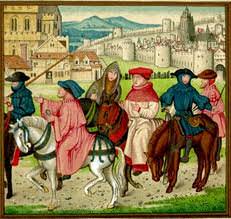“Ful blissfully in prison maistrow dure”: Pleasure and imprisonment in the Knight’s Tale
Sparks, Corey (Indiana University)
Abstract
Arcite departs from Palamon by wishing him enduring pleasure in his imprisonment. Arcite laments his newly-gained freedom as an imprisionment that is far less pleasing than Palamon’s Troubling an easy binary between captivity and freedom in the Knight’s Tale, Chaucer thus imagines imprisonment as a site for productive pleasures. These productive pleasures, I will argue, threaten to suspend the captives indefinitely and make them exchangeable with one another. At stake in such an imagining are the philosophical, political, and poetic uses for which the trope of imprisonment gets deployed.
At the end of Book one of the Knight’s Tale Arcite tells Palamon to ‘enjoy your imprisonment’. Productive pleasures threaten the captives. This story details the capture of two knights who fall in love with Emily. Both promise each other not to go afetr Emily’s love. In the end, they battle for her, Arcite wins Emily’s hand but his horse trips and he is crushed and dies. Palamon ends up with Emily. This paper deals with what happens before Arcite and Palamon are separated. The paper also touches on “cosmic order”.
Freedom and imprisonment are confused in Chaucer – i.e., newly gained freedom is imprisonment because Arcite is no longer in contact with Emily; he can’t look at her. Conversely, Palamon argues that Arcite is free and his fate stuck behind is the true imprisonment. Both Palamon and Arcite locate freedom as imprisonment – prison is painful but also pleasurably productive. Sparks argued for 3 ways in which prison gives them pleasure:
1.) The speculative pleasure of prison – Arcite and Palamon get to “see” Emily. The act of seeing her is pleasurable – what he termed playfully as, “scope-a-philia”.
2.) Poetically – once Emily appears, they can’t stop their poetic outpourings and their chivalric fantasies ensue.
3.) Homo-sociability – Palamon and Arcite go through this experience together. ‘The audience of desire’ – Arcite and Palamon are a captive audience for each other. They could easily replace one another and the reader would never know. They are exchangeable in their poetic production; they feel and lament not just to each other but for each other.
Sparks asked, ‘Why would Chaucer make pleasure in imprisonment?’ This tale exposes the shallowness of contemplation, examines fantasies of rescue, and the social exposure of each knight’s presence. Palamon and Arcite gain a lot from their imprisonment. Lastly, Sparks spoke to the idea of interesting things occurring in places of confinement such as prisons and in religious orders – the pleasure associated with these places.
SESSION 8: Spaces Real and Imagined
“Ful blissfully in prison maistrow dure”: Pleasure and imprisonment in the Knight’s Tale
Sparks, Corey (Indiana University)
Abstract
Arcite departs from Palamon by wishing him enduring pleasure in his imprisonment. Arcite laments his newly-gained freedom as an imprisionment that is far less pleasing than Palamon’s Troubling an easy binary between captivity and freedom in the Knight’s Tale, Chaucer thus imagines imprisonment as a site for productive pleasures. These productive pleasures, I will argue, threaten to suspend the captives indefinitely and make them exchangeable with one another. At stake in such an imagining are the philosophical, political, and poetic uses for which the trope of imprisonment gets deployed.
At the end of Book one of the Knight’s Tale Arcite tells Palamon to ‘enjoy your imprisonment’. Productive pleasures threaten the captives. This story details the capture of two knights who fall in love with Emily. Both promise each other not to go afetr Emily’s love. In the end, they battle for her, Arcite wins Emily’s hand but his horse trips and he is crushed and dies. Palamon ends up with Emily. This paper deals with what happens before Arcite and Palamon are separated. The paper also touches on “cosmic order”.
Freedom and imprisonment are confused in Chaucer – i.e., newly gained freedom is imprisonment because Arcite is no longer in contact with Emily; he can’t look at her. Conversely, Palamon argues that Arcite is free and his fate stuck behind is the true imprisonment. Both Palamon and Arcite locate freedom as imprisonment – prison is painful but also pleasurably productive. Sparks argued for 3 ways in which prison gives them pleasure:
1.) The speculative pleasure of prison – Arcite and Palamon get to “see” Emily. The act of seeing her is pleasurable – what he termed playfully as, “scope-a-philia”.
2.) Poetically – once Emily appears, they can’t stop their poetic outpourings and their chivalric fantasies ensue.
3.) Homo-sociability – Palamon and Arcite go through this experience together. ‘The audience of desire’ – Arcite and Palamon are a captive audience for each other. They could easily replace one another and the reader would never know. They are exchangeable in their poetic production; they feel and lament not just to each other but for each other.
Sparks asked, ‘Why would Chaucer make pleasure in imprisonment?’ This tale exposes the shallowness of contemplation, examines fantasies of rescue, and the social exposure of each knight’s presence. Palamon and Arcite gain a lot from their imprisonment. Lastly, Sparks spoke to the idea of interesting things occurring in places of confinement such as prisons and in religious orders – the pleasure associated with these places.
Subscribe to Medievalverse
Related Posts